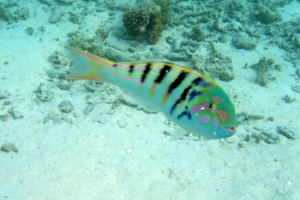Description
Also known as Hardwick Wrasse, Hardwicki Wrasse, Hardwick's Wrasse, Lunate-tailed Wrasse, Six-banded Wrasse, Six-barred Wrasse.
Found in small loose schools along drop-offs and slopes of shallow lagoons and seaward reefs.
They feed on small benthic crustaceans, fish and zooplankton.
Often get close to divers in case they disturb the bottom so they can forage for food.
Length - 20cm
Depth - 0-15m
Widespread Indo-Pacific
Most reef fish seen by divers during the day, are grazers, they cruise around, just above the surface of the coral, or snoop into crevices, foraging for food.
Wrasses have small protruding teeth, which they use to graze the bottom, taking in a variety of algae, crustaceans, such as crabs, eggs, shrimps, snails and worms. Any hard coats or thick shells, are then ground down by their pharyngeal jaws, and the delicacies inside digested.
From juvenile to adult, wrasses dramatically alter their colour and body shapes.
Wrasses are always on the go during the day, but are the first to go to bed and the last to rise.
Small wrasses dive below the sand to sleep, and larger wrasses wedge themselves in crevices. Ref: https://www.fishbase.se/summary/5643











0 comments